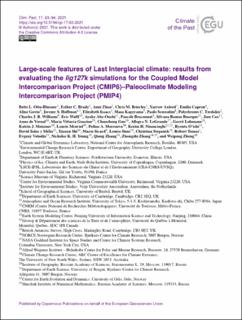| dc.contributor.author | Otto-Bliesner, Bette L. | |
| dc.contributor.author | Brady, Esther C. | |
| dc.contributor.author | Zhao, Anni | |
| dc.contributor.author | Brierley, Chris M. | |
| dc.contributor.author | Axford, Yarrow | |
| dc.contributor.author | Capron, Emilie | |
| dc.contributor.author | Govin, Aline | |
| dc.contributor.author | Hoffman, Jeremy S. | |
| dc.contributor.author | Isaacs, Elizabeth | |
| dc.contributor.author | Kageyama, Masa | |
| dc.contributor.author | Scussolini, Paolo | |
| dc.contributor.author | Tzedakis, Polychronis C. | |
| dc.contributor.author | Williams, Charles J.R. | |
| dc.contributor.author | Wolff, Eric W. | |
| dc.contributor.author | Abe-Ouchi, Ayako | |
| dc.contributor.author | Braconnot, Pascale | |
| dc.contributor.author | Ramos Buarque, Silvana | |
| dc.contributor.author | Cao, Jian | |
| dc.contributor.author | de Vernal, Anne | |
| dc.contributor.author | Vittoria Guarino, Maria | |
| dc.contributor.author | Guo, Chuncheng | |
| dc.contributor.author | Legrande, Allegra N. | |
| dc.contributor.author | Lohmann, Gerrit | |
| dc.contributor.author | Meissner, Katrin J. | |
| dc.contributor.author | Menviel, Laurie | |
| dc.contributor.author | Morozova, Polina A. | |
| dc.contributor.author | Nisancioglu, Kerim H. | |
| dc.contributor.author | O'Ishi, Ryouta | |
| dc.contributor.author | Mélia, David Salas Y. | |
| dc.contributor.author | Shi, Xaoxu | |
| dc.contributor.author | Sicard, Marie | |
| dc.contributor.author | Sime, Louise C. | |
| dc.contributor.author | Stepanek, Christian | |
| dc.contributor.author | Tomas, Robert A. | |
| dc.contributor.author | Volodin, Evgeny | |
| dc.contributor.author | Yeung, Nicholas K.H. | |
| dc.contributor.author | Zhang, Qiong | |
| dc.contributor.author | Zhang, Zhongshi | |
| dc.contributor.author | Zheng, Weipeng | |
| dc.date.accessioned | 2021-08-17T12:25:54Z | |
| dc.date.available | 2021-08-17T12:25:54Z | |
| dc.date.created | 2021-01-11T17:41:37Z | |
| dc.date.issued | 2021 | |
| dc.identifier.issn | 1814-9324 | |
| dc.identifier.uri | https://hdl.handle.net/11250/2768887 | |
| dc.description.abstract | The modeling of paleoclimate, using physically based tools, is increasingly seen as a strong out-of-sample test of the models that are used for the projection of future climate changes. New to the Coupled Model Intercomparison Project (CMIP6) is the Tier 1 Last Interglacial experiment for 127 000 years ago (lig127k), designed to address the climate responses to stronger orbital forcing than the midHolocene experiment, using the same state-of-the-art models as for the future and following a common experimental protocol. Here we present a first analysis of a multi-model ensemble of 17 climate models, all of which have completed the CMIP6 DECK (Diagnostic, Evaluation and Characterization of Klima) experiments. The equilibrium climate sensitivity (ECS) of these models varies from 1.8 to 5.6 ∘C. The seasonal character of the insolation anomalies results in strong summer warming over the Northern Hemisphere continents in the lig127k ensemble as compared to the CMIP6 piControl and much-reduced minimum sea ice in the Arctic. The multi-model results indicate enhanced summer monsoonal precipitation in the Northern Hemisphere and reductions in the Southern Hemisphere. These responses are greater in the lig127k than the CMIP6 midHolocene simulations as expected from the larger insolation anomalies at 127 than 6 ka.
New synthesis for surface temperature and precipitation, targeted for 127 ka, have been developed for comparison to the multi-model ensemble. The lig127k model ensemble and data reconstructions are in good agreement for summer temperature anomalies over Canada, Scandinavia, and the North Atlantic and for precipitation over the Northern Hemisphere continents. The model–data comparisons and mismatches point to further study of the sensitivity of the simulations to uncertainties in the boundary conditions and of the uncertainties and sparse coverage in current proxy reconstructions.
The CMIP6–Paleoclimate Modeling Intercomparison Project (PMIP4) lig127k simulations, in combination with the proxy record, improve our confidence in future projections of monsoons, surface temperature, and Arctic sea ice, thus providing a key target for model evaluation and optimization. | en_US |
| dc.language.iso | eng | en_US |
| dc.publisher | Copernicus Publications | en_US |
| dc.rights | Navngivelse 4.0 Internasjonal | * |
| dc.rights.uri | http://creativecommons.org/licenses/by/4.0/deed.no | * |
| dc.title | Large-scale features of Last Interglacial climate: results from evaluating the lig127k simulations for the Coupled Model Intercomparison Project (CMIP6)–Paleoclimate Modeling Intercomparison Project (PMIP4) | en_US |
| dc.type | Journal article | en_US |
| dc.type | Peer reviewed | en_US |
| dc.description.version | publishedVersion | en_US |
| dc.rights.holder | Copyright Author(s) 2021. | en_US |
| cristin.ispublished | true | |
| cristin.fulltext | original | |
| cristin.fulltext | original | |
| cristin.qualitycode | 1 | |
| dc.identifier.doi | 10.5194/cp-17-63-2021 | |
| dc.identifier.cristin | 1869322 | |
| dc.source.journal | Climate of the Past | en_US |
| dc.source.pagenumber | 63-94 | en_US |
| dc.relation.project | Notur/NorStore: NN9486K | en_US |
| dc.relation.project | EC/FP7/610055 | en_US |
| dc.relation.project | Norges forskningsråd: 246929 | en_US |
| dc.relation.project | Notur/NorStore: NN4659K | en_US |
| dc.relation.project | Notur/NorStore: NN9133K | en_US |
| dc.identifier.citation | Climate of the Past. 2021, 17 (1), 63-94. | en_US |
| dc.source.volume | 17 | en_US |
| dc.source.issue | 1 | en_US |

